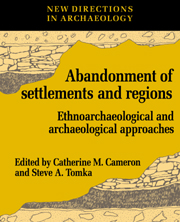Book contents
- Frontmatter
- Contents
- List of figures
- List of tables
- List of contributors
- Acknowledgments
- PART I INTRODUCTION
- 1 Abandonment and archaeological interpretation
- PART II REGIONAL ABANDONMENT PROCESSES: ETHNOARCHAEOLOGICAL CASES
- PART III REGIONAL ABANDONMENT PROCESSES: ARCHAEOLOGICAL CASES
- PART IV ABANDONMENT PROCESSES WITHIN SITES: ETHNOARCHAEOLOGICAL CASES
- PART V ABANDONMENT PROCESSES WITHIN SITES: ARCHAEOLOGICAL CASES
- PART VI CONCLUSIONS
- Index
1 - Abandonment and archaeological interpretation
Published online by Cambridge University Press: 23 May 2010
- Frontmatter
- Contents
- List of figures
- List of tables
- List of contributors
- Acknowledgments
- PART I INTRODUCTION
- 1 Abandonment and archaeological interpretation
- PART II REGIONAL ABANDONMENT PROCESSES: ETHNOARCHAEOLOGICAL CASES
- PART III REGIONAL ABANDONMENT PROCESSES: ARCHAEOLOGICAL CASES
- PART IV ABANDONMENT PROCESSES WITHIN SITES: ETHNOARCHAEOLOGICAL CASES
- PART V ABANDONMENT PROCESSES WITHIN SITES: ARCHAEOLOGICAL CASES
- PART VI CONCLUSIONS
- Index
Summary
Abandonment conjures up images of catastrophe, mass migration, and environmental crisis. Archaeologists are not immune to the “disaster movie” mind set. Most archaeological studies of abandonment have focused on either the regional exodus (the abandonment of the Four Corners Region of the American Southwest at AD 1300) or spectacular cases of rapid abandonment (Pompeii). Since about 1970, abandonment has been increasingly recognized as a normal process of settlement, and, more importantly, identified as a key process in the formation of the archaeological record (e.g. Ascher 1968; Schiffer 1972, 1976, 1985; Stevenson 1982).
Papers in this volume address not simply the causes of abandonment, but the articulation between human behavior at the time of abandonment and resulting patterns in the archaeological record. Combining ethnographic, ethnoarchaeological, and archaeological data from a wide range of geographic areas and time periods, all contributions share the common theme of understanding the effect of abandonment on archaeological patterns. Several papers use data from the North American Southwest where abandonment has been of long–standing interest, while others break new ground in areas as diverse as modern Iran and Copper Age Portugal.
Abandonment can occur at the level of the activity area, structure, settlement, or entire region. All purely archaeological sites have been abandoned, but not all structures or settlements were abandoned in the same way. “Abandonment processes” – those activities that occur during abandonment – include behavior such as curation or caching of tools, dismantling of structures, and the interruption of normal disposal patterns (Schiffer 1987:89–98).
- Type
- Chapter
- Information
- The Abandonment of Settlements and RegionsEthnoarchaeological and Archaeological Approaches, pp. 3 - 8Publisher: Cambridge University PressPrint publication year: 1993
- 16
- Cited by



